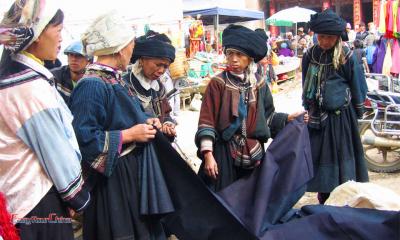Xian Museum and Small Wild Goose Pagoda
Xian Museum is situated two kilometers away from the Xian City Wall (southwest section) in the Beilin District of Xian City. Xian Museum is a collection of museums, places of interest and urban gardens. Now it has become a historical and cultural site for travelers and the local residents to learn the history of Xian and to enjoy a peaceful and relaxed time.
The Small Wild Goose Pagoda, part of the Xi'an Museum, is located within Jianfu Temple, thus is also known as the "Jianfu Temple Pagoda." Built during the Jinglong period of the Tang Dynasty, it, along with the Big Wild Goose Pagoda, remains a significant symbol of the Tang Chang'an City.
On June 22, 2014, at the 38th session of the UNESCO World Heritage Committee, the Small Wild Goose Pagoda was inscribed on the World Heritage List as a site along the Silk Road.
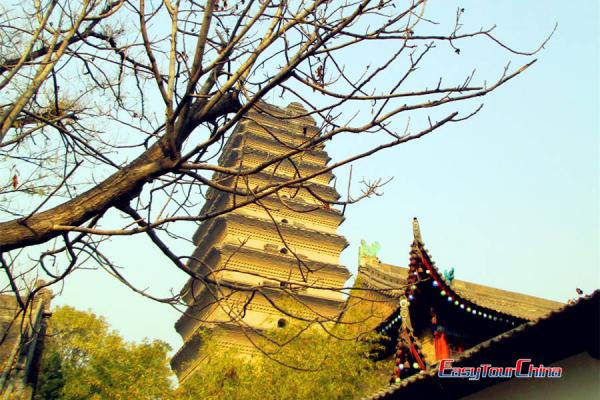
Xian Museum Facts
Small Wild Goose Pagoda Facts
Xian Museum
Xian Museum mainly consists of the ancient Jianfu Temple built in the year 684 A.D during the Tang Dynasty (618-907) and the famous Small Wild Goose Pagoda, combining the grand museum, ancient pagoda and the tranquil park as a whole. Covering an area of 40.4 acres, it’s renowned for its thousand-year old pagoda, garden-style relic as well as the modern history museum of the ancient capital Xi 'an.
Jianfu Temple was built by Li Dan, an emperor of the Tang dynasty, to tribute his father, thus it’s an influential royal temple in Tang dynasty and a major venue for translating Buddhist scriptures attracting numerous master monks. But the original Jianfu Temple has been distorted during the war of end of Tang dynasty. Fortunately, the relics and collections had been moved into Small Wild Goose Pagoda and got a nice protection. Now, the existing Jianfu Temple ancient buildings group is the repaired one in the Ming and Qing dynasties generally continued the layout of Ming dynasty.
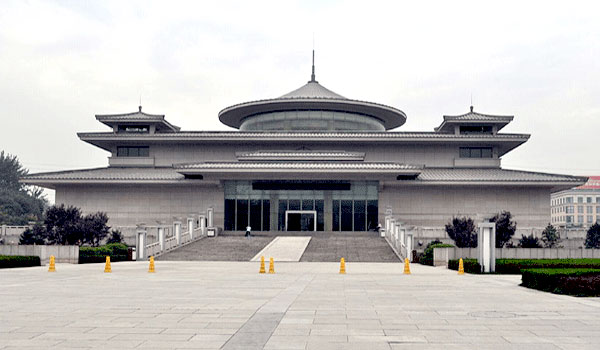
Exhibitions
The museum has three major exhibition sections: the Basic Exhibition Hall, mainly displays the development of ancient Xian and people's social life during the 13 dynasties when Xian was China's capital; the Thematic Exhibition Hall, covers over 120 exhibits of Buddhist statue arts, over 100 works of calligraphy and paintings, about 120 pieces of refined jade articles and more than 200 seals; the Temporary Exhibition Hall, displaying more than 20,000 cultural and historical relics coming from districts and counties of Xian.
Through the thematic display of "ancient capital Xi'an” let you experience the historical changes from the evolution of history and the changes of ancient cultural relics. The scenic area also shows city models from the Zhou dynasty to the Ming and Qing dynasties where you can see the size, layout and living conditions of the capital at that time. In addition, there are more than 130,000 cultural relics unearthed in the Zhou, Qin, Han and Tang dynasties.
If you are interested in Chinese shadow puppetry, you can also see live performances by professional performers in Xian museum.
Important Collections
The Xi'an Museum houses a diverse collection including gold and silverware, pottery, bronze artifacts, paintings and calligraphy, seals, porcelain, jade objects, and Buddhist sculptures. A significant portion of these artifacts were unearthed from historically influential dynasties such as the Zhou, Qin, Han, and Tang.
- Gilded Bronze Door Fittings - Unearthed in 1972 from the Tang Dynasty's Daming Palace site in Xincheng District, Xi'an. Two pieces. Circular plate-shaped. The primary motif features fierce, ferocious beast faces. The backs of the beast heads have forked rivets for insertion into door frames, with the tails bent horizontally to secure the fittings. Likely components of a palace gate.
- Dragon-Patterned Hollow Brick - Rectangular brick from the Han Dynasty. The front decoration employs a “joyful reunion” composition, centered on a bi jade disc, with two dragons turning their heads to gaze at each other, their front claws arched toward the disc.
- Pottery Water Pipe - Unearthed in 2006 at Building Site No. 5 of the Qin Shanglin Garden from the Warring States period, located approximately 500 meters northeast of the Qin Afang Palace Front Hall site.
- Glazed Ceramic Watchtower - Also from the Han Dynasty. Three-story pavilion style with a rectangular base. Total height 136 cm; base measures 40 cm long and 38 cm wide.
- Jade Qilin - Yuan Dynasty artifact. Height 4.8 cm, length 4 cm, maximum width 1.5 cm.
>> Recommended Xian Tours:
- 4 days Historical and Archeological Study Tour in Xian
- 5 Days Classic Xian Tour with Extension to Luoyang
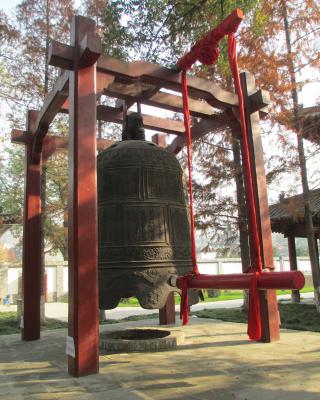
Small Wild Goose Pagoda
The Small Wild Goose Pagoda is a multi-eave and square brick structure built in the year 707 A.D during the Tang dynasty. It is thirteen stories tall, reaching 43.38 meters / 142 feet (It was originally 15 stories high and about 45 meters high. During the great earthquake in 1556, the 34th year of Jiajing in the Ming Dynasty, two floors of the top of the tower were destroyed, and only 13 floors remain.). The pagoda base is made from packed earth in the shape of a hemisphere, thus the pressure can be evenly divided. Images of arhats and designs of grasses, with excellent workmanship reflecting the artistic style of the early Tang Dynasty were carved on the lintel. The construction of the pagoda is a wonder as it has remained standing after over seventy earthquakes with three times cracking and merging.
After the construction of Da Ci’en Temple, a small pagoda was built by another essential monk, Dao’an, with royal sponsors in 707 A.D. To distinguish the two pagodas, people called Da Ci’en Temple Big Wild Goose Pagoda, and the later one that looked like Da Ci’en Temple called Small Wild Goose Pageda.
Cultural Relics
- Tang Dynasty Buddha's Crown Victorious Dharani Sutra Stupa: Located within the “Flower Path” courtyard at the southeast corner of the Small Wild Goose Pagoda, it was carved in the second year of Emperor Wuzong's Huichang reign (842 AD). The stupa is stone-carved, octagonal in shape, measuring 126.3 cm in height, 62 cm in length, 59 cm in width, and 27 cm in depth. It is crowned with a lotus-and-jewel finial and rests on a square base. Each side of the base features two niches with relief carvings depicting musicians performing. The front face of the stupa is inscribed with the Sutra of the Buddha's Crown and the Noble Dharani, followed by the Sutra of the Buddha's Teaching on Rebirth in the Pure Lands of the Ten Directions According to One's Vows.
- Tang Dynasty Stone Buddha: The headless stone Buddha statue unearthed at the foot of the Small Wild Goose Pagoda is the largest Tang Dynasty stone Buddha discovered there. When excavated, the statue was headless, wearing a monk's robe, with both hands broken off, standing upright on a lotus pedestal. Measurements indicate a height of 1.8 meters (including the base) and a width of 70 centimeters.
- Jin Dynasty Iron Bell: Cast in the third year of the Mingchang era of the Jin Dynasty (1192), the bell stands 3.55 meters tall and weighs approximately 8,000 kilograms. During the reign of emperor Kangxi of the Qing dynasty, the big iron bell cast in the Jin dynasty was moved into the temple. Thousands of words were carved on the bell, mostly by mantra. Every morning the bell will be struck regularly, the bell chime sounds sonorous spicing up a unique charm to the ancient city. Therefore the bell becomes one of the highlights of Small Wild Goose Pagoda.
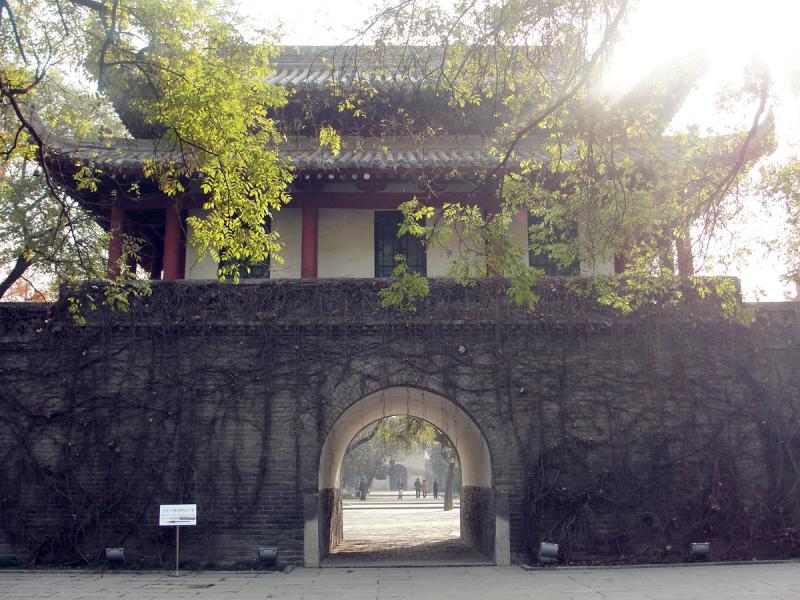
Jianfu Temple Ancient Architecture
Originally constructed in the first year of the Wenming era (684 AD) during the Tang Dynasty, Jianfu Temple was a Buddhist monastery built by Emperor Ruizong Li Dan to dedicate blessings for his father, Emperor Gaozong, after his death. As a renowned imperial temple of the Tang Dynasty, it also served as one of the key sites for translating Buddhist scriptures during that era. The temple attracted many eminent monks of the Tang Dynasty, among whom Master Yijing was the most celebrated. Jianfu Temple was destroyed during the wars at the end of the Tang Dynasty. Later, the temple relocated to the Pagoda Precinct, the site of today's Small Wild Goose Pagoda. From the Five Dynasties to the Yuan Dynasty, Chang'an's city walls were scaled back, leaving Jianfu Temple and the Small Wild Goose Pagoda outside the city limits. The original temple complex in the southern half of Kaihua Ward gradually fell into disrepair.
The existing ancient architectural complex of Jianfu Temple was reconstructed during the Ming and Qing dynasties. The layout largely follows the design from its reconstruction during the Zhengtong era of the Ming Dynasty. The temple buildings are concentrated along the central axis aligned with the Small Wild Goose Pagoda, starting from the south gate and extending northward. These include the South Gate, Bell and Drum Towers, Maitreya Pavilion, Great Hero Hall, Sutra Repository, Small Wild Goose Pagoda, and White Robe Pavilion. The temple also houses folk artifacts such as stone figures and horse pillars, alongside various folk art exhibitions.
Since the Kangxi era of the Qing Dynasty, the temple gained fame for its iron bell cast during the Jin Dynasty. When the monks struck it at dawn, its clear tones resonated far and wide. Combined with the graceful silhouette of the Wild Goose Pagoda, this scene became one of the “Eight Scenic Views of Guanzhong”—the “Morning Bells of the Wild Goose Pagoda.”
The temple grounds are home to ten ancient and renowned trees, nine of which are Chinese scholar trees and one a zelkova. These trees are estimated to be between 800 and 1,300 years old. Five of the scholar trees are situated on either side of the central axis in front of the Great Buddha Hall, while the remaining four are located in the courtyard south of the Maitreya Pavilion and between the Bell and Drum Towers.
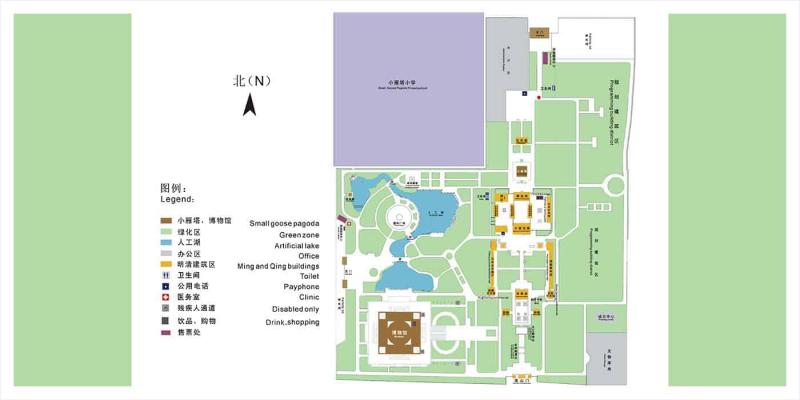
How to Get To Xian Museum and Small Wild Goose Pagoda?
If you want to take the subway, Line 2 and Line 5 are okay. Get off at Nanshaomen Station and walk for 7 minutes, then you can reach the scenic spot.
Or you can take Bus 18, 21, 18, 21, 29, 32, 40, 46, 203, 204, 218, 224, 258, 407, 410 or Sightseeing Line 7 to Xiaoyanta (Small Wild Goose Pagoda) Stop. It’s 3-minute walking away from the museum.
>> Recommended China Silk Road Tours with Small Wild Goose Pagoda:
